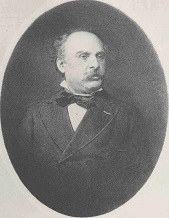
Born into a Jewish family of Strasbourg, Emile Waldteufel was the favorite composer of empress Eugénie. He wrote hundreds of waltzes, including the famous Valse des patineurs (The Skater’s Waltz) that all Europe whistled…
La Valse des patineurs (The Skater’s Waltz) is one of the most famous waltzes in the world. Many people think Johan Strauss wrote it. But they are wrong! The Skater’s Waltz was written by Emile Waldteufel, French musician born in Strasbourg in 1837 into a Jewish family. His grand-father, Moyse Lévy was a traveling musician in Bischheim (Alsace).
Due to the Napoleonian decree of July 28th 1808 forcing all the Jews to have a “definite name” in order to facilitate their survey and civil-state registry, Moyse Lévy chose to be called Waldteufel.
One of his sons, Lazare Lévy aka Louis Waldteufel (1801-1884), fiddler and conductor, had four sons: Achille (1830-?), Isaac (1832-1884), called Léon, court conductor for balls, and Charles-Emile (1837-1915), called Emile, who was the most famous and prolific composer of the family.
In 1844, his family went to Paris in order for Léon to learn violin in the Conservatory. Then it was Emile, from 1853 to 1857, who was enrolled to learn the piano; Jules Massenet and Georges Bizet were his classmates. Waldteufel, like many other pianists during that time, composed his works on the piano, but with the potential for future orchestration depending on for which kind of performance it would be used (private salons, ballrooms or outside balls).
During the Second Empire, Waldteufel wrote many dances which made him known. In 1865, particularly liked by Eugénie, he became director of dance music of the imperial court of Napoleon III and the entitled pianist of the empress. He was put in charge of the famous dance evenings of Biarritz and Compiègne. From 1867 on, Waldteufel’s orchestra performed for the balls in the Tuileries Garden, following the practice of Isaac Strauss.
In 1874, he got noticed by the Prince of Wales, the future Edward VII, who gave him the opportunity to become known in Great-Britain. He then signed a contract with the editing company of London Hopwood & Crew which allowed him to be played during the balls of Queen Victoria at the Buckingham Palace. His music was at the top of the programs for many years. The Skater’s Waltz (1882) gave him an international fame, and he was then played in London, Berlin and Paris with great success until the beginning of the 20th century.
Waldteufel’s music is defined by a melodic pattern in the tradition of French composers of the time such as Gounod, Saint-Saëns or Bizet. His inspiration went from comical operas by Audran, Lacome or Offenbach to more popular Bavarian music (that he knew from his mother) or Bohemian folklore. His abundant work mainly contains music for dancing: waltzes, polkas and mazurkas, as well as several melodies that had made his reputation.
Excerpts of this biography were taken from Wikipedia
Listen to the music of Waldteufel on YouTube
Listen to the radio show dedicated to Emile Waldteufel, hosted by Laure Schnapper
Browse our archives on Emile Waldteufel




